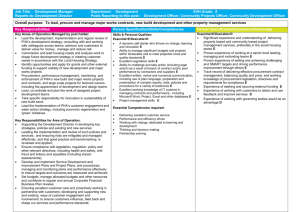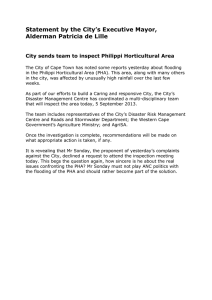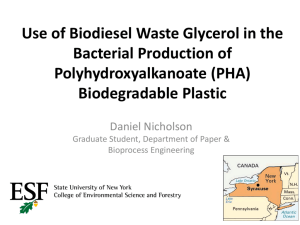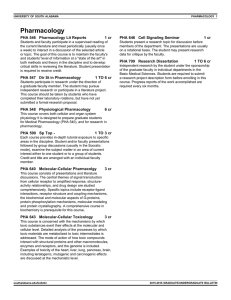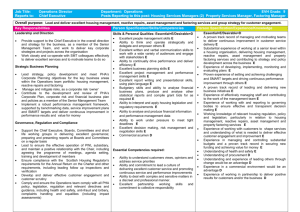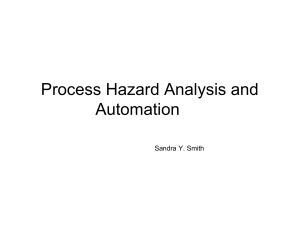Process Hazard Analysis Fundamentals Walt Frank, Frank
advertisement
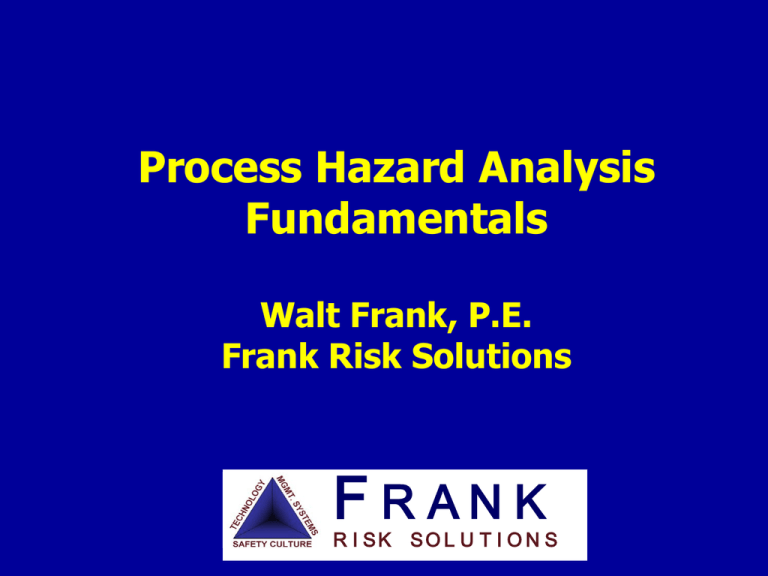
Process Hazard Analysis Fundamentals Walt Frank, P.E. Frank Risk Solutions FR ANK R I SK SO L U T I O N S Walt Frank, PE • • • • • B.S. CheE, Rose-Hulman Institute of Technology 24 years with DuPont 10+ years with ABS Consulting President, Frank Risk Solutions, Inc. Emeritus member of American Institute of Chemical Engineers (AIChE) Center for Chemical Process Safety (CCPS) • AIChE and CCPS Fellow • NFPA member and chair of the Technical Committee on Handling and Conveying of Dusts, Vapors, and Gases 2 Focus Of This Presentation • Provide basic understanding of: – Requirements for PHAs in NFPA 654 – How to conduct, document, and follow up on a Process Hazard Analysis (PHA) 3 What is a PHA? An organized effort to identify and evaluate hazards associated with chemical processes and operations to enable their control. This review normally involves the use of qualitative techniques to identify and assess the significance of hazards. Conclusions and appropriate recommendations are developed. Occasionally, quantitative methods are used to help prioritized risk reduction. AIChE, Center for Chemical Process Safety (CCPS) 4 What is a Hazard? An inherent chemical or physical characteristic that has the potential for causing damage to people, property, or the environment. … it is the combination of a hazardous material, an operating environment, and certain unplanned events that could result in an accident. CCPS 5 Why Do A PHA? • It is required by NFPA 654 • Hazard/risk controls are expensive • We seek confidence that: – We understand the hazards in the process – We can identify the most appropriate means of controlling those hazards – The controls we apply will be effective in addressing the hazard – We know how to maintain the effectiveness of those controls over time – We are not wasting resources on unneeded or ineffective controls 6 NFPA 654 Requirements 4.2 Process Hazard Analysis. 4.2.1* The design of the fire and explosion safety provisions shall be based on a process hazard analysis of the facility, the process, and the associated fire or explosion hazards. 4.2.2 The results of the process hazard analysis shall be documented and maintained for the life of the process. 4.2.3 The process hazard analysis shall be reviewed and updated at least every 5 years. A.4.2.1 One method by which this requirement can be satisfied is with a process hazard analysis conducted in accordance with the methods outlined by the AIChE Center for Chemical Process Safety in Guidelines for Hazard Evaluation Procedures. 7 Goals of PHA • Identify the hazards inherent with an activity – We cannot evaluate the hazards we are not aware of • Identify process upsets, human errors, and equipment failures that could manifest these hazards in the form of incident scenarios leading to undesired consequence (e.g., injuries, equipment damage, environmental damage, etc.) 8 Hazard Identification • Hazards that are not identified cannot be analyzed • Yes… our process materials are combustible • But how about: – – – – Health hazards? Chemical reactivity? Conductivity (high or low)? Propensity to electrostatic charging? 9 Goals of PHA • Identify and evaluate existing protections against such scenarios and consequences • Determine whether additional protections are necessary, and propose such protections as warranted 10 Some Important PHA Concepts • Preparation for the PHA • Proper team make-up • Correct and up-to-date information to support PHA • Selection of appropriate PHA technique(s) • Effective conduct of the meetings • Clear documentation of PHA results • Timely, effective implementation of PHA recommendations 11 Some Common PHA Techniques • • • • • • Hazard and Operability Analysis (HAZOP) Checklist Analysis What If Analysis What If/ Checklist Analysis Failure Modes and Effects Analysis (FMEA) Layers of Protection Analysis (LOPA) 12 HAZOP Overview • Detailed/rigorous technique developed in the chemical industry • Looks at the design intent of the process and assesses what might happen if operations deviate from that intent • Analysis proceeds step-wise through the process • Each relevant process parameter is assessed (flow, temperature, pressure, composition, etc.) 13 HAZOP Overview • Guidewords are applied to process parameters to construct deviations from process intent – More flow, less flow, no flow, reverse flow – More pressure, less pressure – More (Higher) temperature, less (lower) temperature • Deviations from intent are assessed for safety significance 14 HAZOP Overview • Where concerns are identified – Potential consequences are estimated – Likelihood may be estimated – Existing protections are identified and evaluated for effectiveness – Additional protections are proposed, as warranted 15 HAZOP – Step-By-Step • Identify the process/activity to be assessed • Section the process into discrete nodes for which a succinct design intent can be described • Describe the design intent for each node, documenting relevant process parameters, e.g.: – “Unload the contents of the tank truck into the silo in 45 minutes or less.” – “Feed 500 lbs/hr to the spray dryer, maintaining a product exit temperature of no more than 175o F.” 16 HAZOP – Step-By-Step • Select a process parameter and apply a guide word to create the first deviation; e.g., “Higher temperature” • Determine if there are any undesired safety consequences for this deviation – Note: it is conventional to assume any existing protection fail when estimating consequences… to ensure a conservative estimate • If so, identify the potential causes for the deviation 17 HAZOP – Step-By-Step • Identify existing protections (engineered, administrative, etc.) – Note: protections may be specific to a particular cause or a particular consequence • Optional: risk rank the accident scenario being studied (more on this later) • Determine if additional protections are warranted, and propose as appropriate 18 HAZOP – Step-By-Step • Select the next guide word, apply to same process parameter, and repeat above process • Repeat for all relevant guidewords • Repeat for all relevant process parameters • Repeat for all process nodes 19 HAZOP – Summary • HAZOP is clearly a detailed analytical technique – Designed to ensure comprehensive analysis of complex process situations • HAZOP may not be appropriate for your situation – May be “too big a tool” 20 HAZOP – Summary • HAZOP exemplifies the underlying thought processes that are inherent in all PHAs – What is supposed to happen when things are “normal”? – What can go wrong... and how? – How bad can it be? – How likely is this to happen? – How are we currently protected? – Do we need more protection? • The other PHA techniques (discussed later) all seek to answer these same questions 21 Preparing for the PHA • Some basic considerations: – Define analytical scope of PHA (not unusual for a site to require multiple PHAs) – Assemble/compile required supporting information – Identify the PHA team – Get agreement/endorsement of all involved individuals/groups – Agree on the schedule – Arrange meeting room and logistical issues • On-site or off-site? 22 Assemble Supporting Information • Required information may include: – Process flow diagrams (or piping and instrumentation diagrams) – MSDSs and other sources of hazard information for the process chemicals – Process descriptions – Operating procedures – Information on safety systems – Incident investigation reports – Etc. • Information should be accurate and up-to-date 23 PHA Team Make-Up • The PHA Team should be led/facilitated by someone with experience in the conduct of PHAs and familiarity with the technique(s) selected • The PHA Team should, at a minimum provide knowledge on the following topics: – – – – – – The process and procedures The equipment and maintenance practices Process materials and their hazards Safety systems and their functions Emergency response systems and procedures (Possibly) building construction and fire resistance 24 PHA Team Make-Up • PHA Teams typically contain the following membership: – – – – – – – Team leader/facilitator Scribe Operator and/or operations supervisor Mechanic and/or maintenance supervisor Process engineer Health and Safety representative Other specialized expertise as needed • One person may represent several functions • Avoid “tag team participation” 25 Preparing the PHA Team • Depending upon the team member’s past experience, the PHA leader may need to provide some training on the PHA process and the technique(s) selected • A tour of the process to be studied may help the team focus in its thinking 26 Conducting the Meetings • The success of the PHA is highly dependent upon having a skilled, experienced team leader – Keeps team focused, keeps energy level up • Identify and evaluate problems, but do not engineer solutions • Maintain focus on worst credible events • Seek outside expertise when needed • Avoid bogging down, identify “stuck” issues for later resolution • Accurately document the team deliberations 27 Other PHA Techniques • • • • • Checklist Analysis What If Analysis What If/Checklist Analysis Failure Modes and Effects Analysis Layers of Protection Analysis (LOPA) 28 Checklist Analysis • Uses a prepared list of questions or topics to prompt the hazard assessment – Is the question/topic applicable to the system being assessed? – If the question/topic proposes a particular protective feature, is this present in the system? – What other concerns do the question/topic prompt? – What additional protections may be warranted? • Checklists must prepared before the PHA – Companies with similar processes/equipment may develop checklists specific to their needs/experience • Some may find NFPA 654 to be a useful checklist 29 What If Analysis • The least-structured of the techniques • PHA team brainstorms potential safety problems, assessing significance, existing protections, need for additional protections • Highly dependent upon knowledge/experience of team members and effective team leadership • Useful when relevant checklists are not available 30 What If/Checklist Analysis • Conduct brainstorming What If first, followed by the more structured Checklist to “fill in the gaps” – Analysis process is not constrained by the content of the prepared checklist – Combined approach is not solely reliant on team experience 31 Failure Modes and Effects Analysis • FMEA focuses on equipment systems – Mechanical processing equipment – Control systems, such as dryer temperature control – Protective systems, such as interlocks • Assesses: – How can each major component in the system fail? – What would the resulting effects (consequences) be? – What protections currently exist to mitigate the failure? – What additional protections may be warranted? 32 Technique Selection • Each technique has its niche • For example, FMEA can be effective in assessing complex equipment systems, while HAZOP addresses complex process operations • Often, a PHA may use a combination of techniques; e.g.: – HAZOP supplemented by one or more checklists – FMEA to evaluate one particularly important safety system identified in a checklist analysis • A skilled PHA leader should be familiar with all techniques and know when to draw upon each 33 Risk Ranking • Risk expresses the likelihood of experiencing a certain consequence – For example, fatalities/year • Risk ranking is commonly used in HAZOP, can be expanded to other techniques • Each scenario is assessed for – Consequences (assuming protections fail) – Likelihood of occurrence (allowing credit for protections) • Estimates can be on a qualitative or semiquantitative basis 34 Risk Ranking • Consequence and likelihood are combined to estimated the likelihood of loss (risk) – Usually using a risk matrix • Risk ranking can allow rational prioritization of recommendations – Higher risk scenarios warrant higher priority 35 Risk Ranking 36 Risk Ranking Example Consequence Categories – Qualitative Risk Matrix Category Description 1 No injury or health effects 2 Minor to moderate injury or health effects 3 Moderate to severe injury or health effects 4 Permanently disabling injury or fatality 37 Risk Ranking Example Frequency Categories – Qualitative Risk Matrix Category Description 1 Not expected to occur during life of process/facility 2 May occur once during life of process/facility 3 May occur several times during life of process/facility 4 Expected to occur more than once in a year 38 Risk Ranking 39 Risk Ranking Example Risk Ranking/Response Categories – Qualitative Risk Matrix Risk Level Description Required Response Unacceptable Immediate mitigation or termination of activity II High Mitigation within 6 months III Moderate Mitigation within 12 months IV Acceptable As Is No mitigation required I 40 Layers of Protection Analysis • Technique for assessing the number of safety layers required to achieve a tolerable level of risk for a particular scenario “7.1.2 Explosion Protection for Equipment…… (a) Where oxygen monitoring is used, it shall be installed in accordance with ISA 84.00.01, Functional Safety: Application of Safety Instrumented Systems for the Process Industry Sector.” • More detailed discussion of LOPA is beyond today’s scope 41 Documentation • PHA must be clearly, effectively documented • Documentation should address: – Scope of analysis – Team members and qualifications – Information used in support of analysis (with revision number or date, where appropriate) – Results of the analysis (typically in tabular form) – Recommendations • PHA documentation must be kept for the life of the process 42 Recommendation Follow-up • Properly follow-up on recommendations protects the investment in time and resources that went into the PHA – Many organization trip up by not following up – Legal liabilities, in addition to safety concerns, in failing to address recommendations in timely fashion • Document, for each recommendation: – Responsible party – Due date • Track each recommendation to resolution – Enforcing expectations that due dates will be met – Implement formal extension process for rare exceptions 43 Recommendation Follow-up • Include in PHA documentation: – Date recommendation closed out – How it was closed out (what actually was done) • Close out recommendations only after required actions have been implemented – Do not close out recommendations based upon a future intent to do something 44 Recommendation Follow-up • Recommendations may be rejected for cause – Further analysis shows the recommendation was based upon erroneous conclusions, will not enhance safety – Changing circumstances remove need for recommendation – Recommendation is not feasible (but look for alternate means of satisfying underlying intent of recommendation) • Justification for rejection should be clearly documented 45 PHA Revalidation • NFPA 654 requires that the PHA be reviewed and updated at least every 5 years • Guidance for determining the appropriate approach to doing so can be found in CCPS publication Revalidating Process Hazard Analyses 46 Questions? For follow-up: Walt Frank Frank Risk Solutions, Inc. 302-521-7588 WLF@FrankRisk.com 47

